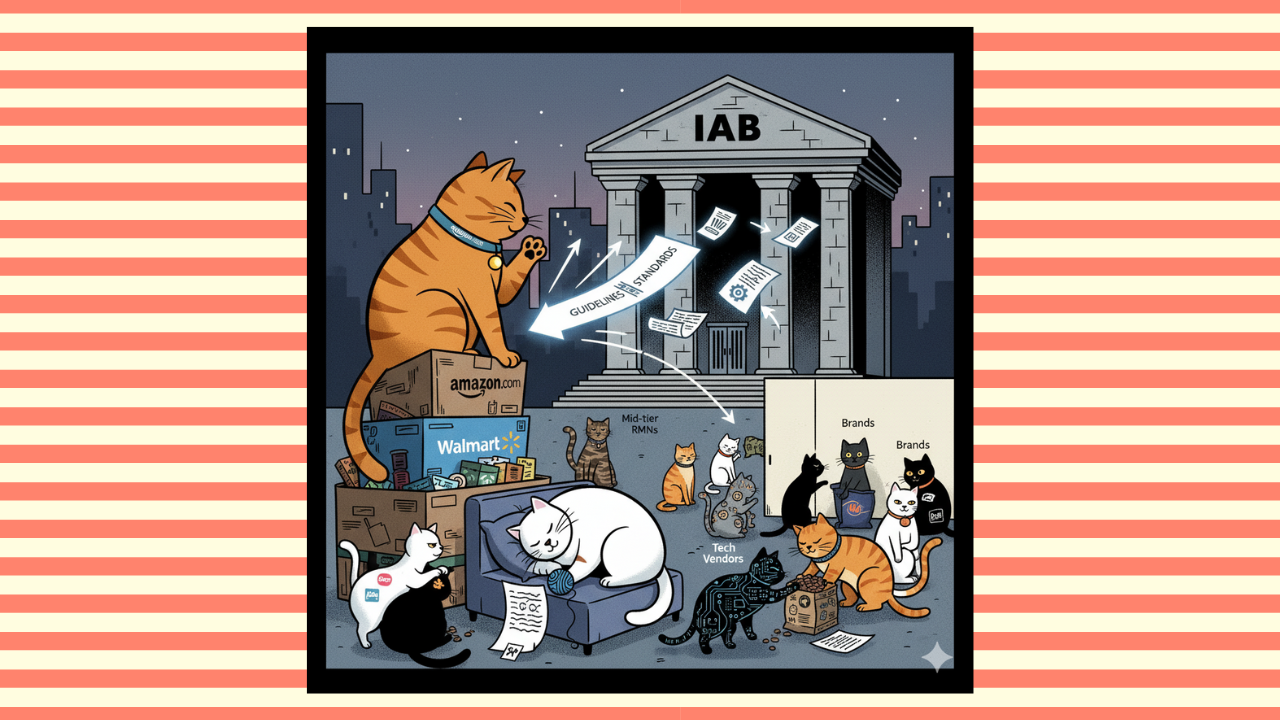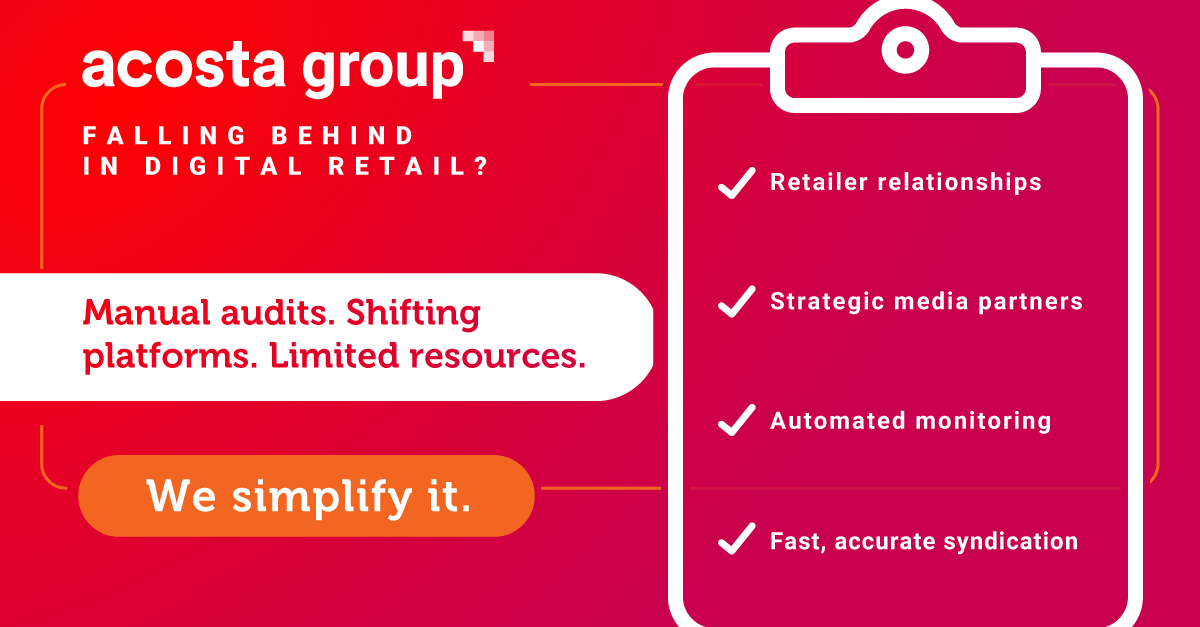Retail Media's Measurement Problem: It's Not Just the Retailers
The IAB and MRC has been herding cats in an effort to engage the retail media industry in measurement standards. Industry participants have various explanations as to why adoption is not yet widespread.

I just published a 2,000-word deep dive for WARC on why retail media still lacks widely-adopted measurement standards. The short answer? Everyone shares the blame—retailers, brands, and the tech infrastructure holding it all together.
WARC is making the full article free for the next six days, so grab it before it disappears behind the paywall. For now, here are the highlights.
The Standards Exist. So Why Aren't They Working?
The IAB and Media Rating Council released comprehensive retail media measurement guidelines back in 2024. Retailers acknowledge their value—Sukanya Swetharanyan, Product Lead for Audiences, Measurement & Insights at Albertsons Media Collective, calls them "a great resource to strive towards," and Vai Anand, Senior Director of Data Science at Dollar General Media Network, has adopted the gold-standard approaches they recommend, like randomized controlled trials.
But here's the uncomfortable reality: the largest retail media networks often see little reason to push for industry-wide standards. As one senior leader put it to me, they feel like mid-tier networks are asking advanced players to dumb down their capabilities to meet less mature benchmarks.
Meanwhile, adoption remains patchy because each party has reasons not to move too fast.
We're Obsessing Over the Wrong Thing
The industry keeps debating which metric to use when we should be debating methods instead.
The IAB guidelines actually get this right—they focus on approaches that prove causality (RCTs, matched market tests) rather than elevating any single metric. But then media buyers try to rank every network by ROAS, even when objectives differ completely.
Melanie Babcock, VP of Orange Apron Media at Home Depot, gave me a perfect example in an interview earlier this year: A supplier might launch an exclusive faucet color at Home Depot with 200 SKUs over several months, while that same supplier only lists their top 10 SKUs at a mass retailer. Completely different assortment, objectives, and timelines. How can you possibly judge them by the same ROAS number?
Her solution? Optimize to "return on marketing objective"—judge incrementality against the goal of that specific retailer relationship, not some universal benchmark.
When your time, budget and team are already maxed out, keeping up with retailer platforms and media requirements can feel like a never-ending labyrinth. That’s why even the best brands bring in an execution partner.
Acosta Group makes retail media execution simpler. They stay ahead of every platform update, tech shift, and media spec. So your campaigns actually show up and perform—without draining your team.
Buyers Are Part of the Problem
Collin Colburn, Commerce Lead at the IAB, didn't mince words when I asked about brand responsibility: "Brands have contributed to these challenges because they'll ask for custom metrics, reports, attribution windows from retailers. These requests perpetuate the very problems everyone claims they want to solve."
Anand at Dollar General sees this constantly. Traditional CPG marketers are deeply familiar with marketing mix modeling but struggle with incrementality concepts. So even when Dollar General implements gold-standard testing, they spend time justifying their approach instead of proving value.
The paradox: Brands say they want comparability while actively undermining it by pushing for bespoke reporting.
The Infrastructure Problem Is Real
Given all these challenges, I wanted to understand whether retail media faces unique measurement obstacles compared to other digital channels—or if we're just making excuses.
The Measurement Infrastructure Gap:
• Identity fragmentation – Can't tie exposures to outcomes across networks → Identity spines like LiveRamp's RampID are creating universal connectors
• Siloed impression logs – Cross-network deduplication nearly impossible → Clean rooms enabling secure data sharing without exposing PII
• Tech stack assembly – Most networks cobble together non-retail-native partners → Platforms like MadConnect building pre-configured connectors
• Legacy systems – Built for speed, not comparability → Best Buy and Home Depot rebuilding from the ground up
Retail media grew up too fast. Networks sprinted to market with whatever tech they could assemble, and now many are stuck with fragmented systems that weren't built for standardized reporting.
As one retail media leader told me: "The problem isn't that the IAB guidelines are wrong—it's that the infrastructure they depend on is often broken. Identity stitching, data ingestion, audience creation—these fundamentals are sub-optimal at many networks."
Is Retail Media Actually Harder to Measure?
Given all these challenges, I wanted to understand whether retail media faces unique measurement obstacles compared to other digital channels—or if we're just making excuses.
The superpower: Deterministic closed-loop measurement. You can tie an ad exposure to a household to a sale with near-certainty.
The tradeoff: The walled-garden effect. Impression logs stay siloed, privacy rules limit sharing, and cross-network deduplication becomes frustratingly hard.
But here's the thing: some of this is politics, not physics. The infrastructure exists—IAB frameworks, identity spines, clean rooms for secure data sharing. Refusing to share exposure logs in a clean room is a choice. If a network wants premium budgets, it needs to provide premium proof.
What Progress Actually Looks Like
Some retailers are showing what's possible:
- Best Buy Ads: 93% of transactions tie back to a customer ID, building toward "completely transparent" unified attribution
- Home Depot: Rebuilt their tech stack specifically to meet supplier expectations for standardization
- Dollar General: Implementing RCTs and matched tests based directly on IAB guidance
As Babcock told me: "If you want to be a top retail media network, you need relationships with the governing bodies to show you're following the rules, not building a bespoke system."
The Bottom Line
The practical blockers—identity fragmentation, log sharing, UI silos, and our collective ROAS addiction—are solvable with choices retailers and brands can make right now.
Standards won't arrive by proclamation. They'll happen when the cost of fragmentation finally outweighs the comfort of the status quo. For now, everyone's just comfortable enough with the chaos.
Read the full analysis at WARC (free for the next 6 days)
The extended piece goes much deeper on tech infrastructure, explores the role of SSPs and DSPs in creating workarounds, and includes more perspectives on what "good" actually looks like in practice.






